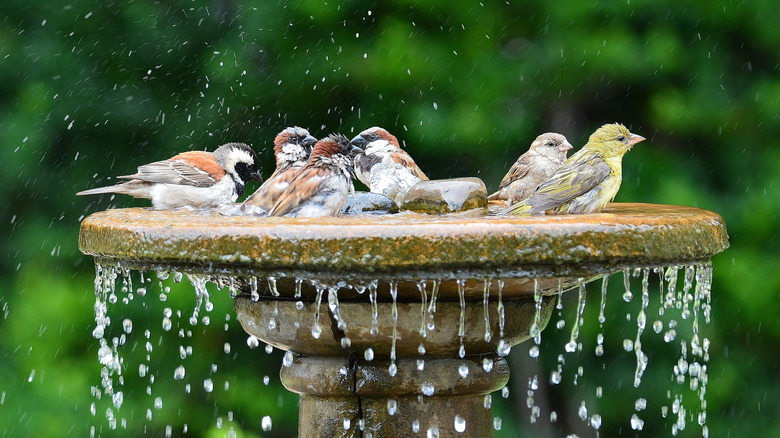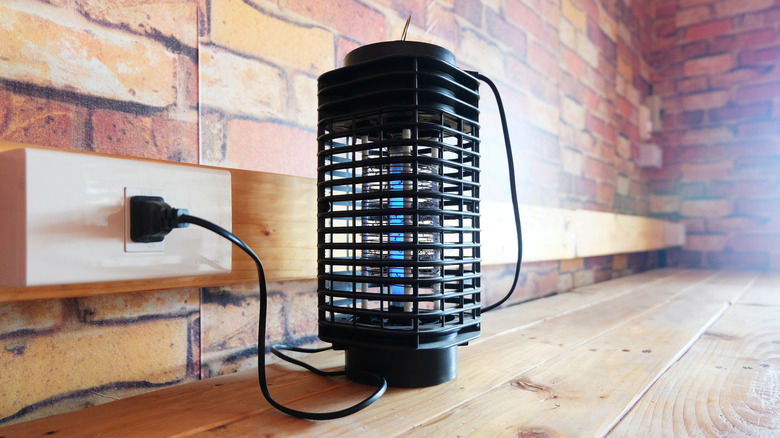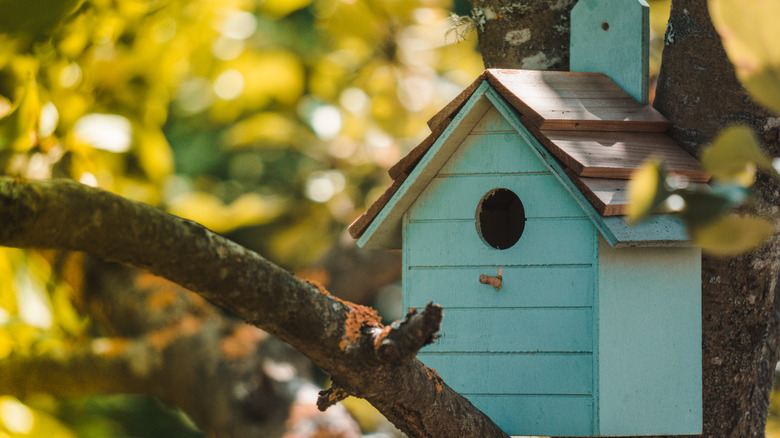The 10 Best Ways To Keep Bugs Away From Your Porch Lights
Are there swarms of bugs every time you turn on your porch light? No one wants to relax on their porch when bugs are constantly flying around them. This is especially true when mosquitos leave everyone covered in itchy bug bites. Getting rid of mosquitos is about more than annoying bites. According to the Center for Disease Control, they can spread viruses like Zika and Malaria.
Luckily, there are some changes that can be made to keep bugs away from your porch lights. There are natural cleaners that you can make with products you likely already have in your home and even certain plants you can add to your garden that will repel insects. Or you can make changes to your home by eliminating any standing water or changing the type of light bulbs you use on your porch. The method that makes the most immediate difference is installing a bug zapper near your porch.
1. Change the light bulb
Changing the lightbulb you use for your porch light is one of the simplest changes you can make to prevent bugs from swarming your porch. Normally bugs are attracted to light and heat, but if you use an LED light bulb, it will actually repel bugs. According to LED Lights Unlimited, LED lights won't attract bugs like normal incandescent light bulbs because they don't emit as much heat. Using yellow or red LED lights will repel bugs even more because these colors make it hard for bugs to see. However, cool-white and warm-white LED lights will also repel bugs.
While this method is good at stopping bugs from swarming the lights on your porch, it won't completely get rid of all the bugs that visit while you're trying to relax out there. If there are still too many bugs, use this method in conjunction with others.
2. Don't leave standing water around your home
Standing water is the perfect breeding ground for bugs like mosquitos. To help stop so many bugs from swarming your porch, you should find the source of all the bugs and remove it. With mosquitos specifically, they lay eggs in and around standing water, so you can reduce the number of mosquitoes near your home if there is no standing water. Standing water is water that doesn't flow or move, which can often be found in bird baths, ponds, and rain barrels.
To get rid of standing water Breda Pest Management recommends a couple of places to make changes. First, look around your home for any buckets and overturn them. You can also get rid of bird baths and bring inside any pet bowls that are left outside. If you have a fountain, either drain and cover it or turn it on so that the water is running. If there are any ponds near your home, you can fill them with fish like koi that will eat mosquito larvae. If you want to keep bird baths and ponds, integrate running water in them to keep things moving and fresh.
3. Install a bug zapper
Bug zappers are another way to redirect where bugs go by attracting them to something that will help get rid of them. By installing a zapper on or near your porch, the bugs will be attracted to it instead of you or the lights. However, having one of these nifty gadgets comes with a few downsides. They work by attracting bugs with a blue UV-A light and then zapping them with electricity so that they die, according to Thanos. The downside to this method is that every time a bug is zapped, you will hear it, and if enough bugs are electrocuted, you will smell it too. Depending on the type of machine you purchase, there may even be a pile of dead bugs on the ground around the bug zapper or in it (that you'll have to empty out from time to time).
There are a couple of different types of bug zappers available. The most well-known one has metal bars around it. Other variations of bug attractants inside these machines include fans that help suck bugs in and sticky tape that they get stuck to when they're attracted inside by the pretty lights.
4. Clean with vinegar and burn citronella candles
Keeping your porch clean is an important step when trying to get rid of bugs. If cleaned regularly, fewer bugs will be drawn to this area. Any spills should be wiped as soon as possible, and the porch should be swept as well. When cleaning this area, a cleaning solution that includes vinegar will help to repel certain types of bugs. According to Medicine Net, vinegar will repel bugs, including ants, mosquitoes, and fruit flies. To use vinegar as a cleanser, mix it in a spray bottle with water in a one-to-one ratio. Use this to wipe down surfaces and spray it around your porch lights or any place you notice large groups of bugs.
Burning citronella candles is another way to repel bugs from any outdoor area you want to enjoy time in. It's a short-term solution, as it only works for a couple of hours, according to Today, but is beneficial when used along with other bug repelling methods. Citronella candles work to repel mosquitoes by emitting a strong smell that covers up the scent of humans so that mosquitoes aren't attracted to the area.
5. Plant insect repelling plants
Planting certain types of plants in your garden or on your porch can help fight against swarms of bugs around your home. Choosing to create a small herb garden on your porch can even help repel bugs if you don't want to invest a lot of time or money to maintain a garden or needy landscaping. Herbs like basil, rosemary, thyme, parsley, fennel, and oregano will repel insects, according to Maggie's Farm. These herbs are particularly good at repelling mosquitoes and house flies. They can be planted in small pots, will need to be watered about once a week, and should receive plenty of sunlight. Along with repelling bugs, a plus to this method is that you will have fresh herbs to cook with.
Peppermint and lavender are other plants that will repel bugs. Peppermint will repel ants, mosquitoes, spiders, and aphids. Other than preventing bugs, peppermint will also leave your porch smelling wonderful. To care for peppermint, it will need partial sun and to be watered at least twice a week. This plant grows quickly and will take over your yard if you are not careful, so it should be kept in a pot. Lavender will also leave your porch smelling beautifully while repelling mosquitos, moths, flies, fleas, and scorpions. Lavender is a hardy plant that likes a lot of sun and to be watered at least once a week.
6. Spray the area with essential oils or use spice pouches
Some essential oils can also help you keep annoying bugs away from the lights on your porch. Just as insects don't like fresh basil, rosemary, and lavender, they also do not like the essential oils from these plants. To make a DIY spray, add a few drops of the essential oil(s) into a bottle with some water. Use it to target areas where insects pester you on the porch. Similarly, if you'll be sitting outside, you can also make a bug repellent for your skin. Just apply one of the essential oils mentioned above to your skin using coconut oil or another carrier oil.
Strategically-placed spice pouches can also work to keep bugs away. Add bay leaves, cinnamon, or lemon and orange zest to the center of a coffee filter. Gather the coffee filter and tie a string around it to make a little spice pouch. Make several pouches like this and hang them near your porch lights or anywhere else bugs are a problem.
7. Install an outdoor ceiling fan
If you have a covered front porch, installing an outdoor ceiling fan could be the solution you've been searching for. The breeze generated by a fan can discourage insects from trying to fly around it, since they have to exert more energy and nutrients to move their bodies through the stronger winds. So, when presented with an alternative area without the same windy conditions, they'll often take it, leaving you with a significant decrease in the number of bugs.
A ceiling fan can also decrease humidity levels on your porch, which means mosquitoes are less likely to be present. Not only that, it will make the space cooler and more comfortable, allowing you to enjoy the outdoors even more. When choosing a fan, be sure to select an outdoor model that is rated to hold up to the elements. Also, opt for one with larger blades, as it will do a better job circulating the air to keep you comfortable and keep bugs away.
8. Keep porch lights off when they're not needed
Turning off your porch lights when they're not needed can also help you control a bug problem. The insects are flying by the fixtures because they are attracted to the illumination and heat they're emitting. The reason is quite interesting. Different types of insects can be either positively or negatively phototactic. Those that are positively phototactic — such as moths and mosquitoes — move towards the light, while cockroaches and other negatively phototactic species move away from the light. The science behind this phenomenon is still not completely clear, but it is believed that positively phototactic insects navigate using the moonlight. So, when they see your porch light, they get confused, thinking it is another moon. This results in them moving back and forth and around the glow, trying to keep their sights set on the "moon."
So, leaving your porch lights off whenever possible can help prevent the bugs from circling around. If you like leaving them on for safety reasons, consider investing in a timer to turn them on once you're back inside and off once the sun comes up. Some bugs may still be present, but not near as many as when the porch was more well-lit.
9. Hang a birdhouse nearby
Inviting a few natural predators can also help you decrease your bug numbers. Birds are known to eat flying insects, so welcoming them to the area may help. One of the best ways to encourage them to stick around is by giving them a comfortable place to stay, such as a birdhouse. Start by choosing the ideal spot for the house. You want to choose somewhere that isn't too far from your porch, but also not right on top of it. After all, you want to ensure gathering birds don't become a new problem for you. If a tree isn't close enough, you can attach the birdhouse to a ground post along the walkway or flower bed near the porch.
Once you've set it up, you want to ensure the birds want to visit. Periodically refill the house with birdseed or some fruit. You should soon have some winged guests stopping by to help thin down the pest population.
10. For serious problems, screen the porch or reach out to pest control
None of the solutions shared above will offer a 100% fix to your problem. If you've tried everything and there are still too many bugs flying around, it may be time to try something a bit more drastic. One option is to screen-in your front porch. Just as the screens on your windows keep bugs outside your house, screens on the side of the porch can work to keep pests out. You can enjoy your outdoor space without worrying about getting bitten alive — whether it's day or night.
If you don't have the funds to screen your porch or its layout isn't conducive to adding them, you may want to consider hiring a professional. An exterminator can help you evaluate the cause of the problem and may be able to propose more effective solutions than what you've already tried. They'll be able to work with you to find out what will help get rid of the pests that are driving you mad.










